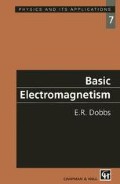Abstract
Electric charge has been known since the Greeks first rubbed amber and noticed that it then attracted small objects. Little further progress was made until the eighteenth century when du Fay showed that there were two sorts of charge. One sort followed the rubbing of an amber rod with wool, the other a glass rod with silk. It was Benjamin Franklin who arbitrarily named the latter a positive charge and the original amber one a negative charge. He also showed that the total charge in a rubbing experiment was constant.
Access this chapter
Tax calculation will be finalised at checkout
Purchases are for personal use only
Preview
Unable to display preview. Download preview PDF.
Author information
Authors and Affiliations
Rights and permissions
Copyright information
© 1993 E. R. Dobbs
About this chapter
Cite this chapter
Dobbs, E.R. (1993). Electrostatics. In: Basic Electromagnetism. Physics and Its Applications. Springer, Dordrecht. https://doi.org/10.1007/978-94-011-2112-5_2
Download citation
DOI: https://doi.org/10.1007/978-94-011-2112-5_2
Publisher Name: Springer, Dordrecht
Print ISBN: 978-0-412-55570-1
Online ISBN: 978-94-011-2112-5
eBook Packages: Springer Book Archive

